
Parmelia is a genus of medium to large foliose lichens. It has a global distribution, extending from the Arctic to the Antarctic continent but concentrated in temperate regions. There are about 40 species in Parmelia. In recent decades, the once large genus Parmelia has been divided into a number of smaller genera according to thallus morphology and phylogenetic relatedness.

The Pannariaceae are a family of lichens in the order Peltigerales. Species from this family have a widespread distribution, but are especially prevalent in southern temperate regions.

Graphis is a genus of lichen-forming fungi in the family Graphidaceae.

Fissurina is a genus of lichenized fungi in the family Graphidaceae. It has about 160 species, most of which are found in tropical regions.

Diorygma is a genus of lichen-forming fungi in the family Graphidaceae. The genus was circumscribed by Franz Gerhard Eschweiler in 1824. Species of the genus are widely distributed in tropical and subtropical regions of the world.

Acanthothecis is a genus of lichen-forming fungi in the family Graphidaceae. The genus was circumscribed by Frederick Edward Clements in 1909.

Protopannaria is a genus of seven species of lichenized fungi in the family Pannariaceae. The genus was originally circumscribed as a subgenus of the genus Pannaria by Hungarian lichenologist Vilmos Kőfaragó-Gyelnik. Per Magnus Jørgensen and Stefan Ekman promoted Protopannaria to full status as a genus in 2000.
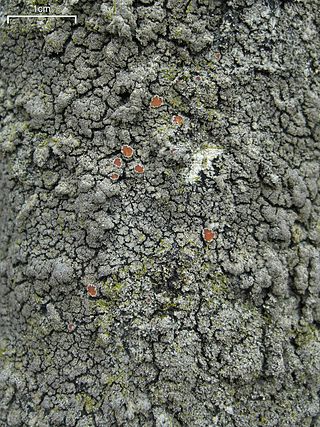
Parmeliella is a genus of lichenized fungi in the family Pannariaceae. It occurs mainly in the tropics and sub-tropics, with species found in Africa, Asia, Australasia and South America. A recent (2020) estimate places 41 species in the genus.

Pannaria is a genus of lichen-forming fungi in the family Pannariaceae. The widespread genus contains an estimated 51 species, found primarily in tropical regions.
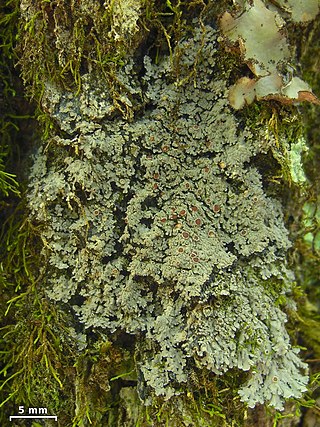
Fuscopannaria is a genus of lichen-forming fungi in the family Pannariaceae. It has 55 species.
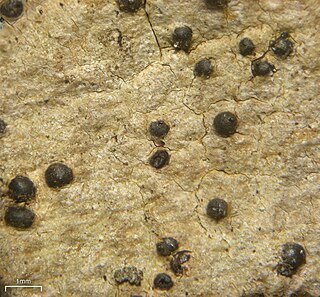
Lithothelium is a genus of lichen-forming fungi in the family Pyrenulaceae. Most of the species are found in tropical climates, and are usually corticolous (bark-dwelling) or saxicolous (rock-dwelling). The genus was circumscribed by Swiss botanist Johannes Müller Argoviensis in 1885.

Leptogium is a genus of lichen-forming fungi in the family Collemataceae. It has about 110 species. Species formerly classified under Leptogium have since been divided among the genera Leptogium, Pseudoleptogium, and Scytinium. Leptogium lichens are predominantly found on tree bark or soil, often among mosses, and sometimes on rocks in moist environments.
Lepidocollema wainioi is a species of lichen in the family Pannariaceae. It is known from southeast Asia.
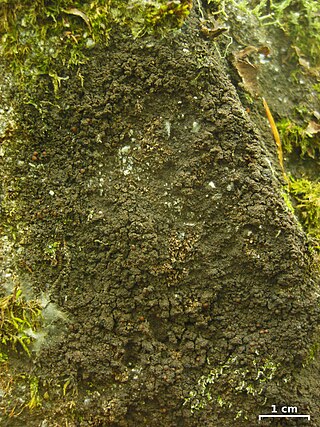
Vahliella is a genus of nine species of lichen-forming fungi in the order Peltigerales. It is the only member of Vahliellaceae, a family circumscribed in 2010 to contain this genus. Vahliella was formerly placed in the family Pannariaceae until molecular phylogenetics showed that it did not belong there. Vahliella species are found in the Northern Hemisphere – mainly in North America, but also in Europe and India.
Gibbosporina is a genus of 13 species of foliose lichens in the family Pannariaceae. It contains species that molecular phylogenetic analysis clustered together in a clade previously referred to as the "Physma"-group. Despite their morphological differences, this group shares several uniting characteristics. They have ring-like excipular margins around the thallus; strongly amyloid internal ascus structures; well-developed perispores that feature irregular gibbae, but not verrucae ; lacks secondary compounds than can be detected by thin-layer chromatography; and have tropical distributions.

Coenogonium is a genus of crustose lichens in the monotypic family Coenogoniaceae. It has about 90 species. Most species are leaf-dwelling or grow on bark, although a few are known to grow on rocks under certain conditions, and some are restricted to growth on termite nests. The genus was circumscribed in 1820 by German naturalist Christian Gottfried Ehrenberg.
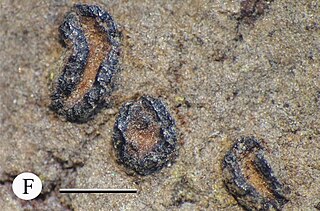
Allographa is a genus of script lichens in the family Graphidaceae. It has nearly 200 species. Formally circumscribed in 1824 by François Fulgis Chevallier, Allographa was formerly included in Graphis, but was upgraded to generic status in 2018 by lichenologists Klaus Kalb and Robert Lücking.

Lepidocollema marianum is a species of cyanolichen in the family Pannariaceae. It was first scientifically described by Elias Fries in 1825 as Parmelia mariana. Per Magnus Jørgensen transferred it to the genus Lepidocollema in 2014 following a molecular phylogenetics-guided revision of the Pannariaceae.

Rostania is a genus of lichen-forming fungi in the family Collemataceae. These lichens are primarily found on tree bark, occasionally on wood, with one species known to inhabit soil. The genus is characterized morphologically by having minute thalli made of hyphal tissue without a separate cortex, and the more or less cuboid-shaped ascospores.
Aspidothelium is a genus of lichen-forming fungi in the family Thelenellaceae. All species in the genus have a tropical distribution and are crustose with a chlorococcoid photobiont partner. Most Aspidothelium species are foliicolous (leaf-dwelling), although some corticolous (bark-dwelling) species are known, as well as a single saxicolous (rock-dwelling) member.
















